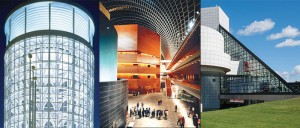ASTM A500 has been the preferred material specification in the United States for cold formed, welded carbon steel hollow structural sections (HSS) since the late 1970s. In April of 2013, a new material specification, ASTM A1085, was released for steel tubes used in structural applications.
The development of A1085 took approximately six years and was led by the American Institute of Steel Construction’s (AISC’s) HSS Marketing Committee. The goal of the Committee, which also included HSS producers, was to improve the efficiency and performance of the HSS members in three main areas: material, seismic design and bridge design.
Traditionally, ASTM A500 allowed for a wall thickness tolerance of -10% of the value specified. Hence, manufacturers have produced tubes with a design thickness of up to 10% less than the nominal thickness required by the standard. This reduction in material led to recommendations made jointly between AISC and the Steel Tube Institute (STI), leading to provisions (AISC 2010 Specification for Structural Steel Buildings ANSI/AISC 360-10, Section B4.2) requiring a reduction in the nominal thickness of all HSS members by 7% for all HSS section calculations. In comparison, A1085 tightens the wall thickness tolerance to -5% and adds a new mass tolerance of -3.5%. These tighter restrictions better align HSS tolerances with other structural members and eliminate the need for the 0.93 factor in calculations. Obviously, these improvements result in more efficient designs when utilizing HSS.
Designers are aware A500 includes four distinct grades of steel for different HSS section shapes, each having different yield and tensile strengths. A1085 greatly simplifies these values for the designer. The specification has one grade and one yield strength (of 50 ksi) for all HSS shapes. This value represents an increase over A500 Grade B, offering another potential savings.
Bending a flat plate of steel into a square or rectangle shape requires careful attention to the radius of the corners. Too tight of a bend could lead to cracking, which often is not visible until a weld is made along the corner of the member and is subjected to extreme heat. A500 lists a maximum corner radius but does not limit the minimum radius bend, whereas A1085 specifies both a minimum and maximum for the reasons listed above. For material that is less than 0.4-inch thick, the corner radius is permitted to be between 1.6t and 3.0t. For material greater than 0.4-inch thick, the lower bound of the corner radius is 1.8t. Most domestic manufacturers produce tubes with a corner radius of 2t so there will be little difference in the workable flat face of a tube.
A common application of HSS members is in a braced frame to resist seismic load. HSS sections are often utilized as the bracing element due to their efficiency in carrying both tension and compression loads. This efficiency has come at a price when designing a building with a resistance factor (R) of greater than 3. The seismic provisions of AISC 360 require an engineer to focus on the actual capacity of a member in order to control the failure mechanism of the lateral force resisting system. To realize the actual capacity of a steel brace, a designer must multiply the specified yield strength by an overstrength factor (Ry) to account for inherent overstrength in steel members. Ry for A500 is 1.4, while Ry for A992 is 1.1. Clearly, the larger Ry results in a nearly 30% increase in force the designer must account for. The high Ry for A500 is due to the high variability in acceptable yield strength of tubes. A1085 specifies an upper bound on the yield strength of 70 ksi. In time, this upper bound limit will logically lead to better predictability of the material strength, a lower Ry factor, and more economical seismic designs utilizing HSS members.
Historically, HSS members have not been used frequently in pedestrian and vehicular bridges, but the demand to utilize these architecturally pleasing shapes in transportation structures has increased. According to the American Association of State Highway and Transportation Officials (AASHTO), sufficient fracture toughness is a requirement for primary bridge members. Accordingly, A1085 includes a Charpy V-notch test requirement of 25 ft-lb at 40°F. This corresponds to an AASHTO Temperature Zone 2, which is applicable throughout the majority of the United States. If more stringent requirements must be met, A1085 carries a supplement that may be specified. Hence, A1085 allows for the usage of HSS shapes in the transportation field by meeting the requirements of AASHTO.
A1085 is already an option for designers when selecting a material to use for design in software packages. STI has been in contact with most major design software companies to better educate them on the intricacies and advantages of new specification. RISA, SCIA Engineer, RAM Structural System and RAM Elements all will include the new material and section properties in their updates to be released in the near future, with other software packages to follow. AISC has surveyed domestic manufacturers on A1085 production and the results of that survey are available on the AISC website (www.aisc.org/hss) along with section properties and column load tables for A1085. Further, the new section properties are also available on STI’s website (www.steeltubeinstitute.org/hss/tech-brochures), and any questions on A1085 may be submitted in the Contact section to be answered by STI’s Technical Consultants.▪

